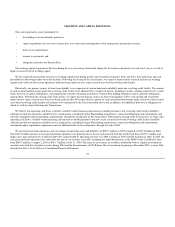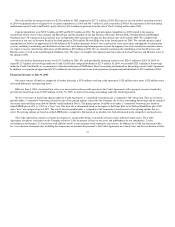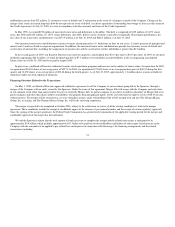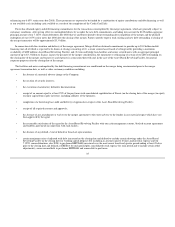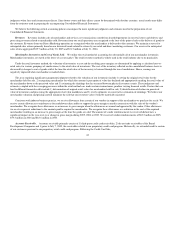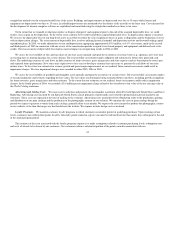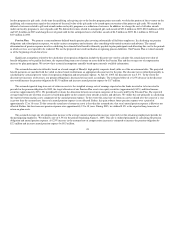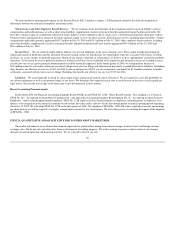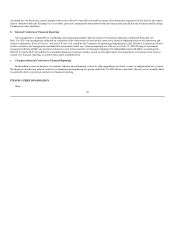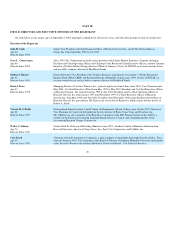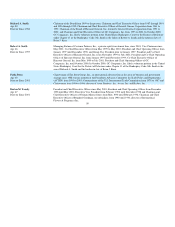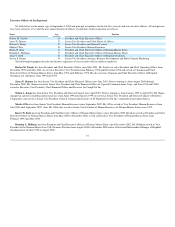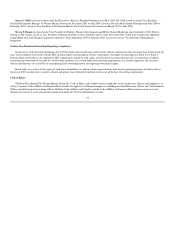Neiman Marcus 2004 Annual Report Download - page 45
Download and view the complete annual report
Please find page 45 of the 2004 Neiman Marcus annual report below. You can navigate through the pages in the report by either clicking on the pages listed below, or by using the keyword search tool below to find specific information within the annual report.
judgments when facts and circumstances dictate. Since future events and their effects cannot be determined with absolute certainty, actual results may differ
from the estimates used in preparing the accompanying Consolidated Financial Statements.
We believe the following critical accounting policies encompass the more significant judgments and estimates used in the preparation of our
Consolidated Financial Statements.
Revenues. Revenues include sales of merchandise and services, net commissions earned from leased departments in our retail stores and delivery and
processing revenues related to merchandise sold. Revenues from our retail operations are recognized at the later of the point of sale or the delivery of goods to
the customer. Revenues from our Direct Marketing operation are recognized when the merchandise is delivered to the customer. We maintain reserves for
anticipated sales returns primarily based on our historical trends related to returns by our retail and direct marketing customers. Our reserves for anticipated
sales returns aggregated $35.7 million at July 30, 2005 and $31.5 million at July 31, 2004.
Merchandise Inventories and Cost of Goods Sold. We utilize the retail method of accounting for substantially all of our merchandise inventories.
Merchandise inventories are stated at the lower of cost or market. The retail inventory method is widely used in the retail industry due to its practicality.
Under the retail inventory method, the valuation of inventories at cost and the resulting gross margins are determined by applying a calculated cost-to-
retail ratio, for various groupings of similar items, to the retail value of inventories. The cost of the inventory reflected on the consolidated balance sheets is
decreased by charges to cost of goods sold at the time the retail value of the inventory is lowered through the use of markdowns. Hence, earnings are
negatively impacted when merchandise is marked down.
The areas requiring significant management judgment related to the valuation of our inventories include 1) setting the original retail value for the
merchandise held for sale, 2) recognizing merchandise for which the customer's perception of value has declined and appropriately marking the retail value of
the merchandise down to the perceived value and 3) estimating the shrinkage that has occurred between physical inventory counts. These judgments and
estimates, coupled with the averaging processes within the retail method can, under certain circumstances, produce varying financial results. Factors that can
lead to different financial results include 1) determination of original retail values for merchandise held for sale, 2) identification of declines in perceived
value of inventories and processing the appropriate retail value markdowns and 3) overly optimistic or conservative estimation of shrinkage. We believe our
merchandise valuation and pricing controls minimize the risk that our inventory values would be materially misstated.
Consistent with industry business practice, we receive allowances from certain of our vendors in support of the merchandise we purchase for resale. We
receive certain allowances to reimburse us for markdowns taken and/or to support the gross margins earned in connection with the sales of the vendor's
merchandise. We recognize these allowances as an increase to gross margin when the allowances are earned and approved by the vendor. Other allowances
we receive represent reductions to the amounts paid to acquire the merchandise. We recognize these allowances as a reduction in the cost of the acquired
merchandise resulting in an increase to gross margin at the time the goods are sold. The amount of vendor reimbursements we received did not have a
significant impact on the year-over-year change in gross margin during 2005, 2004 or 2003. We received vendor reimbursements of $83.5 million in 2005,
$79.3 million in 2004 and $83.4 million in 2003.
Accounts Receivable. Accounts receivable primarily consist of 1) third-party credit card receivables, 2) the net trade receivables of the Brand
Development Companies and 3) prior to July 7, 2005, the receivables related to our proprietary credit card program. Historically, we extended credit to certain
of our customers pursuant to our proprietary retail credit card program. Following the Credit Card Sale,
42


